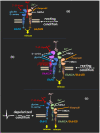Presynaptic release-regulating NMDA receptors in isolated nerve terminals: A narrative review
- PMID: 33347605
- PMCID: PMC9328659
- DOI: 10.1111/bph.15349
Presynaptic release-regulating NMDA receptors in isolated nerve terminals: A narrative review
Abstract
The existence of presynaptic, release-regulating NMDA receptors in the CNS has been long matter of discussion. Most of the reviews dedicated to support this conclusion have preferentially focussed on the results from electrophysiological studies, paying little or no attention to the data obtained with purified synaptosomes, even though this experimental approach has been recognized as providing reliable information concerning the presence and the role of presynaptic release-regulating receptors in the CNS. To fill the gap, this review is dedicated to summarising the results from studies with synaptosomes published during the last 40 years, which support the existence of auto and hetero NMDA receptors controlling the release of transmitters such as glutamate, GABA, dopamine, noradrenaline, 5-HT, acetylcholine and peptides, in the CNS of mammals. The review also deals with the results from immunochemical studies in isolated nerve endings that confirm the functional observations.
Keywords: GluN subunit; glutamate; glycine; presynaptic NMDA receptor; synaptosomes; transmitter release.
© 2020 The Authors. British Journal of Pharmacology published by John Wiley & Sons Ltd on behalf of British Pharmacological Society.
Conflict of interest statement
The author declares no conflicts of interest.
Figures


Similar articles
-
Functional interactions between presynaptic NMDA receptors and metabotropic glutamate receptors co-expressed on rat and human noradrenergic terminals.Br J Pharmacol. 2007 Aug;151(7):1087-94. doi: 10.1038/sj.bjp.0707280. Epub 2007 Jun 25. Br J Pharmacol. 2007. PMID: 17592518 Free PMC article.
-
Immuno-Pharmacological Characterization of Presynaptic GluN3A-Containing NMDA Autoreceptors: Relevance to Anti-NMDA Receptor Autoimmune Diseases.Mol Neurobiol. 2019 Sep;56(9):6142-6155. doi: 10.1007/s12035-019-1511-8. Epub 2019 Feb 7. Mol Neurobiol. 2019. PMID: 30734226
-
Presynaptic glutamate receptors regulate noradrenaline release from isolated nerve terminals.J Neurochem. 1992 Jan;58(1):204-11. doi: 10.1111/j.1471-4159.1992.tb09297.x. J Neurochem. 1992. PMID: 1345765
-
Presynaptic Release-Regulating mGlu1 Receptors in Central Nervous System.Front Pharmacol. 2016 Aug 31;7:295. doi: 10.3389/fphar.2016.00295. eCollection 2016. Front Pharmacol. 2016. PMID: 27630571 Free PMC article. Review.
-
Presynaptic Release-regulating Metabotropic Glutamate Receptors: An Update.Curr Neuropharmacol. 2020;18(7):655-672. doi: 10.2174/1570159X17666191127112339. Curr Neuropharmacol. 2020. PMID: 31775600 Free PMC article. Review.
Cited by
-
Presynaptic 5-HT2A-mGlu2/3 Receptor-Receptor Crosstalk in the Prefrontal Cortex: Metamodulation of Glutamate Exocytosis.Cells. 2022 Sep 28;11(19):3035. doi: 10.3390/cells11193035. Cells. 2022. PMID: 36230998 Free PMC article.
-
Ketamine administration in idiopathic epileptic and healthy control dogs: Can we detect differences in brain metabolite response with spectroscopy?Front Vet Sci. 2023 Jan 6;9:1093267. doi: 10.3389/fvets.2022.1093267. eCollection 2022. Front Vet Sci. 2023. PMID: 36686158 Free PMC article.
-
Attenuation of Stimulated Accumbal Dopamine Release by NMDA Is Mediated through Metabotropic Glutamate Receptors.ACS Chem Neurosci. 2023 Apr 6;14(8):1449-58. doi: 10.1021/acschemneuro.2c00777. Online ahead of print. ACS Chem Neurosci. 2023. PMID: 37022746 Free PMC article.
-
Anti-NMDA and Anti-AMPA Receptor Antibodies in Central Disorders: Preclinical Approaches to Assess Their Pathological Role and Translatability to Clinic.Int J Mol Sci. 2023 Oct 5;24(19):14905. doi: 10.3390/ijms241914905. Int J Mol Sci. 2023. PMID: 37834353 Free PMC article. Review.
-
Involvement of P2Y1, P2Y6, A1 and A2A Receptors in the Purinergic Inhibition of NMDA-Evoked Noradrenaline Release in the Rat Brain Cortex.Cells. 2023 Jun 22;12(13):1690. doi: 10.3390/cells12131690. Cells. 2023. PMID: 37443726 Free PMC article.
References
Publication types
MeSH terms
Substances
LinkOut - more resources
Full Text Sources
Other Literature Sources
Miscellaneous

